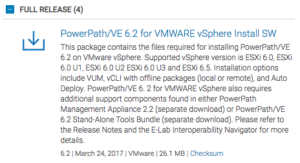

Okay so we’ll just work on the assumption that you’ve got all your PowerPath/VE license issues worked out at this point and you’re safe to upgrade. Rpowermt check_registration host=192.0.2.1


#Emc powerpath license password
The first time you use the rpowermt command it will probably make you establish a lockbox password where it stores host credentials don’t lose that password.

#Emc powerpath license upgrade
Tell it to check for upgrades, it knows to look in the ‘cdrom drive’, it will find the upgrade and run it, then you just need to SSH in and reboot it and you’re done. Next, connect via https to your vApp’s IP address on port 5480 it will want the root user/pass. The upgrade is super easy extract the ISO, stick it on a datastore your vApp has access to, map a cdrom drive to it. I actually had a version 1.0 appliance running so there is also a download of PowerPath_Virtual_Appliance_1.2_P01_Upgrade_only.zip ( LINK) for upgrades.
#Emc powerpath license install
In any case, for a new install of the vApp, you’ll want to (currently) download PowerPath_Virtual_Appliance_1.2_P01_New_Deployment.zip ( LINK). It also makes the license management not too difficult although their whole license management model for PowerPath/VE in served mode still completely sucks from an ongoing maintenance perspective since you’ll lose your licenses with each ESXi host reboot (more on that later). Everything I’m seeing online suggests they’re ultimately going to require that so may as well get it out of the way now. First and foremost, I recommend that you download and begin to use EMC’s vApp virtual appliance for managing your PowerPath licenses.You should do this, read the first item to see why, but if you don’t want to, skip to the next section: This first section will be only for people who are already running, or choose to begin running, the EMC vApp virtual appliance for PowerPath licensing. If you already have a working install of some prior version of PowerPath/VE, you should not encounter any issues as long as you do everything in the right order. This is actually fairly easy as far as upgrades go.


 0 kommentar(er)
0 kommentar(er)
